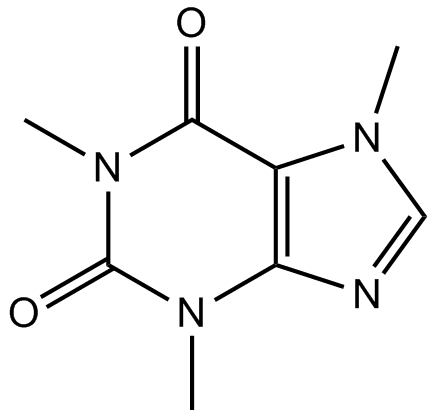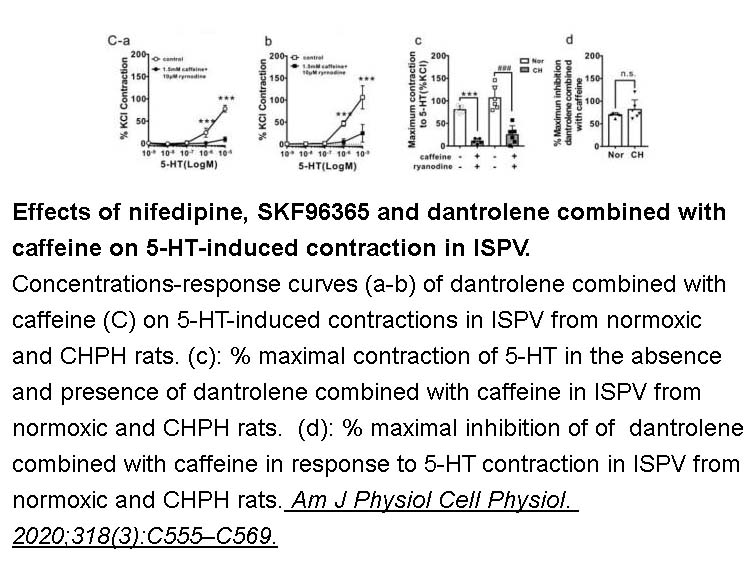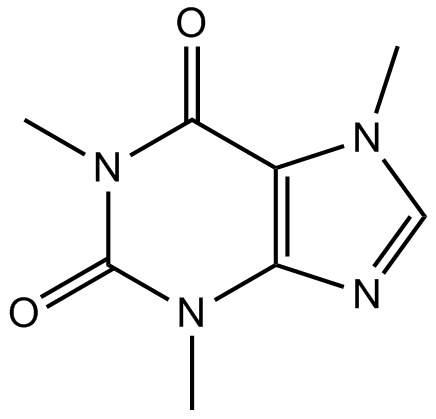Caffeine
Extracted from tea, coffee fruit; Store the product in sealed, cool and dry condition
- 1. Courtney O Kelson, Josiane Weber Tessmann, et al. "Upregulation of Fatty Acid Synthase Increases Activity of β-Catenin and Expression of NOTUM to Enhance Stem-like Properties of Colorectal Cancer Cells." Cells. 2024 Oct 8;13(19):1663 PMID: 39404424
- 2. Yi Liu, Hui Chen, et al. "Notum enhances gastric cancer stem-like cell properties through upregulation of Sox2 by PI3K/AKT signaling pathway." Cell Oncol (Dordr). 2023 Sep 26. PMID: 37749430
- 3. Wu X, Lu W, et al. "Structural and functional definition of the pulmonary vein system in a chronic hypoxia-induced pulmonary hypertension rat model." Am J Physiol Cell Physiol. 2020;318(3):C555–C569. PMID: 31940248
| Physical Appearance | A solid |
| Storage | Store at -20°C |
| M.Wt | 194.19 |
| Cas No. | 58-08-2 |
| Formula | C8H10N4O2 |
| Solubility | insoluble in EtOH; ≥25 mg/mL in H2O; ≥33.33 mg/mL in DMSO |
| Chemical Name | 1,3,7-trimethylpurine-2,6-dione |
| SDF | Download SDF |
| Canonical SMILES | C[n]1c(C(N(C)C(N2C)=O)=O)c2nc1 |
| Shipping Condition | Small Molecules with Blue Ice, Modified Nucleotides with Dry Ice. |
| General tips | We do not recommend long-term storage for the solution, please use it up soon. |
| Cell experiment [1]: | |
|
Cell lines |
Patient-derived AC-UPS01 and AC-RMS01 cell lines |
|
Preparation method |
The solubility of this compound in DMSO is >10 mM. General tips for obtaining a higher concentration: Please warm the tube at 37°C for 10 minutes and/or shake it in the ultrasonic bath for a while. Stock solution can be stored below -20°C for several months. |
|
Reacting condition |
0.25, 0.5, 1, 2.5 and 5 mM; 72 h |
|
Applications |
Caffeine significantly inhibited the patient-derived UPS and RMS cell lines in a dose-dependent manner with IC50 values of 2.02 ± 0.22 mM and 2.37 ± 0.48 mM, respectively. Addition of 0.3 mM or 0.6 mM VPA to varying concentrations of CAF enhanced efficacy against both the AC-UPS01 and AC-RMS01 cell lines. |
| Animal experiment [2]: | |
|
Animal models |
diet-induced obesity (DIO) mice |
|
Dosage form |
10 μg per mouse, i.c.v. administration |
|
Application |
In diet-induced obesity (DIO) mice, administration of caffeine into mouse brain significantly increased the numbers of c-Fos+ cells in the PVN, Arc and DMH nuclei, suggesting that caffeine stimulated the activities of neurons in the hypothalamic nuclei involved in energy balance control. Caffeine reduced the adipocyte sizes of epididymal white adipose tissue, plasma triglycerides (TG) levels and improved glucose tolerance. Mice gained significantly less body weights than the controls on day 7. |
|
Other notes |
Please test the solubility of all compounds indoor, and the actual solubility may slightly differ with the theoretical value. This is caused by an experimental system error and it is normal. |
|
References: [1] Igarashi K1,2,3, Kawaguchi K1,2, Kiyuna T1,2, et al. Efficacy In Vitro of Caffeine and Valproic Acid on Patient-Derived Undifferentiated Pleomorphic Sarcoma and Rhabdomyosarcoma Cell Lines. Anticancer Res. 2017 Aug; 37 (8): 4081-4084. [2] Wu L1, Meng J1, Shen Q1, et al. Caffeine inhibits hypothalamic A1R to excite oxytocin neuron and ameliorate dietary obesity in mice. Nat Commun. 2017 Jun 27; 8: 15904. |
|
Quality Control & MSDS
- View current batch:
Chemical structure

Related Biological Data









